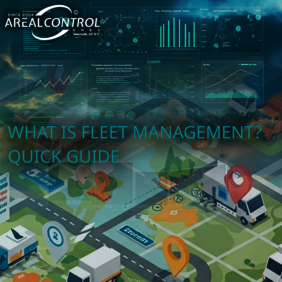Defining Fleet Management Objectives and KPIs
Creating a robust fleet management plan and strategy begins with establishing clear objectives. Fleet managers must identify specific, measurable targets addressing key aspects such as fuel efficiency or driver behavior metrics. These objectives provide direction for the entire fleet operation and form the foundation of your management strategies.
Implementing relevant Key Performance Indicators (KPIs) allows organizations to track progress quantitatively and identify areas for improvement in real-time, creating accountability throughout the system. Effective KPIs might include metrics related to vehicle downtime percentages, maintenance cost per mile, and driver safety scores.
By establishing these benchmarks, fleet managers can better understand operational performance and develop targeted strategies to reduce unnecessary expenses. Cloud-based fleet management software offers powerful tools for automatically tracking these metrics and generating comprehensive reports that highlight trends and anomalies requiring attention. This data-driven approach ensures that objective setting becomes a practical framework guiding daily decision-making and helps prioritize initiatives that deliver the greatest operational and financial benefits.
Analyzing Operational Gaps in Current Fleet Practices
Before implementing new strategies, a thorough assessment of existing fleet practices is essential to identify inefficiencies. Fleet managers should conduct comprehensive audits examining current vehicle utilization rates, maintenance histories, and fuel management procedures. GPS tracking and other telematics data can provide valuable insights into route efficiency, vehicle idle times, and driving habits that may contribute to excessive fuel consumption or premature vehicle wear.
This analysis should extend beyond operational metrics to include administrative processes within the fleet management system. Many organizations discover redundant paperwork, communication breakdowns between departments, or outdated procurement practices creating unnecessary costs and delays. Modern fleet management software can help streamline these workflows by centralizing information and automating routine tasks.
By documenting current practices against industry benchmarks, fleet managers can develop a clear roadmap for improvement addressing both tactical and strategic deficiencies. This methodical approach ensures that strategy development targets genuine needs rather than perceived problems, maximizing the impact of improvement initiatives across the entire fleet.
Building Scalable Fleet Management Strategies Tips
Developing scalable management strategies requires balancing immediate operational needs with long-term organizational objectives. Here are specific standardization processes that create successful, scalable fleet management strategies:
- Vehicle Acquisition Standards: Implement consistent procurement protocols with standardized vehicle specifications by role/function to simplify maintenance, parts inventory, and driver training. For example, standardize on 3-4 vehicle models (depending on the fleet size) across your fleet rather than managing dozens of different makes and models.
- Maintenance Protocol System: Establish tiered preventive maintenance schedules (A, B, and C services) with clearly defined inspection points and service intervals based on mileage or engine hours rather than calendar dates. This creates predictable maintenance workflows that scale efficiently.
- Driver Onboarding Process: Develop a structured onboarding program with standardized training modules, skills verification, and performance benchmarks that can be consistently applied to new drivers regardless of fleet size.
- Fuel Management Framework: Create a unified fueling process using fleet cards with purchase controls, automated odometer readings, and exception reporting to maintain consistent fuel data collection across all vehicles.
- Route Planning Methodology: Implement zone-based routing with standardized time windows and capacity planning that can be replicated as service areas expand, rather than creating unique routes for each new vehicle.
- Documentation Hierarchy: Establish a structured system for vehicle files, compliance records, and operational reports with consistent naming conventions and retention policies that remain functional during growth phases.
Cloud-based fleet management software provides the technological foundation for implementing these standardized processes at scale. By designing with these practical standardization elements as core principles, fleet managers create sustainable systems that accommodate growth without sacrificing efficiency or requiring disruptive overhauls.
Leveraging Telematics Tools for Data-Driven Execution
Modern fleet management relies heavily on telematics and logistics systems that provide unprecedented visibility into daily operations. Tools collect real-time data on vehicle location, engine diagnostics, driver behavior, and fuel consumption patterns, creating a comprehensive digital picture of fleet activities. Fleet managers can use this information to make informed decisions about route optimization, preventive maintenance scheduling, and driver coaching opportunities.
Arealcontrol have developed integrated telematics platforms combining vehicle tracking with additional functionalities such as electronic logbooks, mobile time tracking, and comprehensive transport management systems. These solutions have demonstrated significant operational improvements – in case study, a business with 100 vehicles achieved a 25% reduction in kilometers driven through optimized route planning, translating to monthly savings of over €100,000.
The implementation of telematics represents a shift from reactive to proactive fleet management practices. Rather than responding to breakdowns after they occur, fleet managers can identify potential problems through early warning indicators captured by onboard diagnostics. This predictive approach dramatically reduces unexpected downtime and extends asset lifespans. Similarly, real-time monitoring of driver behavior allows for timely intervention to improve safety records and reduce fuel waste. Organizations fully embracing telematics capabilities often discover opportunities to optimize their entire operation through data-driven strategies that deliver substantial improvements in both performance and cost management.
Continuously Refining Strategies Through Analytics
Sustainable fleet management excellence requires ongoing refinement of strategies based on comprehensive analytics. Fleet managers should establish regular review cycles to examine performance data against established KPIs, identifying trends and anomalies that warrant attention. This continuous improvement approach transforms fleet management into a dynamic practice that evolves with changing business needs and technological capabilities.
Modular telematics solutions provide flexibility for businesses to start with core functionalities like GPS tracking and gradually implement additional features as needs evolve. This scalable approach allows companies to build their capabilities progressively while ensuring seamless integration with existing systems like ERP and CRM platforms through standardized APIs and interfaces.
If you find this article helpful, be sure to check out our article on what is fleet management as well.
